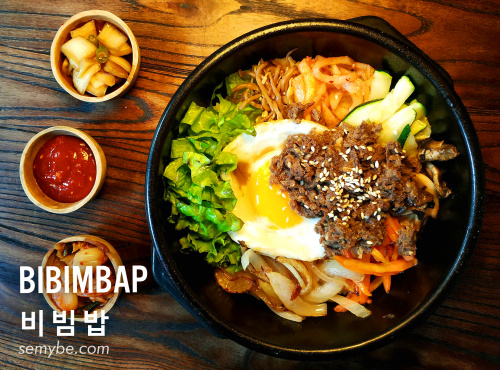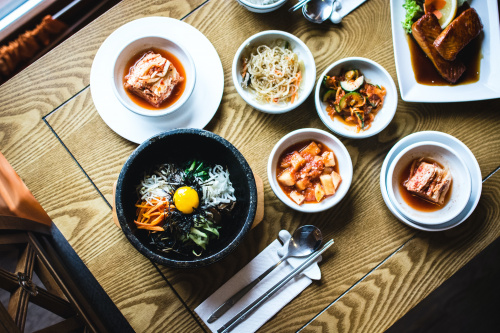
Bibimbap – Korean Mixed Rice
Bibimbap, sometimes spelled beebimbap and pronounced bee-bim-BOP, is a traditional Korean dish comprised of rice, a mixture of vegetables, an egg, and sometimes meat, often served in a hot stone bowl. It’s typically served with sauce, my favorite being Gochujang.
What is Gochujang?
Gochujang is a spicy-sweet Korean sauce that’s typically made of a blend of chilies, glutinous rice, salt, and fermented soybeans. Because most brands are not gluten-free I made my own vegan Gochujang recipe and have to say it’s quite close to the real thing! Plus, it only requires 1 blender, 5 ingredients, and 5 minutes to prepare.

Ingredients for bibimbap (serves 3 to 4):
Meat and meat sauce
- 100g / 3.5 ounces beef mince (or other cuts)
- 1 Tbsp soy sauce
- 1 Tbsp sesame oil
- 1 tsp sugar – I used brown sugar
- 1/4 tsp minced garlic
Vegetables and other
- 250g (0.6 pounds) mildly seasoned spinach
- 350g (0.8 pounds) mildly seasoned bean sprouts – (You don’t have to use them up if you think it’s too much but I love having lots of vegetables on my Bibimbap!)
- 100g (3.5 ounces) shiitake mushroom
- 120g (4.2 ounces) carrots (1 small)
- 1/2 tsp fine sea salt (1/4 tsp each will be used when cooking shiitake mushroom and carrots)
- 3 to 4 serving portions of steamed rice
- 3 or 4 eggs (depending on the serving portion)
- Some cooking oil to cook the meat, mushroom, carrots and eggs – I used rice bran oil.
- Korean seasoned seaweed, shredded (long thin cut)
Bibimbap sauce
- 2 Tbsp gochujang
- 1 Tbsp sesame oil
- 1 Tbsp sugar – I used raw sugar
- 1 Tbsp water
- 1 Tbsp roasted sesame seeds
- 1 tsp vinegar – I used apple vinegar
- 1 tsp minced garlic
Note:
• Other vegetable options – Daikon radish salad, Korean cucumber side dish, gosari and bellflower root
• Feel free to check out my 3 other bibimbap sauces too!
• If you want to learn more about Korean cooking ingredients, check my 30 essential Korean cooking ingredients list!
• 1 Tbsp = 15 ml

Instructions
– If soaking rice, rinse, drain, and add to a mixing bowl and cover with cool water. Soak for 12 hours or overnight. For a quicker soak, cover in hot water for 1 hour. Then rinse and drain.
– To a medium saucepan, add cooking water, rinsed rice, and salt. Heat over high heat and bring to a boil, reduce heat to simmer, and cover. Cook for 15-20 minutes or until water is absorbed and rice is tender and fluffy. Soaked rice generally takes less time to cook. Unsoaked rice can take up to 30 minutes or more. Keep covered and set aside.
– While the rice finishes cooking, heat a large skillet over medium heat (stainless steel or cast iron are best). Once hot, add 1 tsp of sesame oil or enough to just coat the pan.
– Once the oil is hot, add vegetables one type at a time and cook in batches until lightly browned (1-2 minutes), seasoning each with a little minced garlic and a dash of coconut aminos, tamari, or sea salt. Cooking in batches allows you to arrange vegetables separately over the rice for visual effect. We cooked the carrots first, then green onion, bean sprouts, and spinach. Add more oil to the pan as needed between vegetables.
– For meat, mix the beef mince with the meat sauce listed above. Marinate the meat for about 30 mins while you are working on other ingredients to enhance the flavour. Add some cooking oil into a wok and cook the meat on medium high to high heat. It takes about 3 to 5 mins to thoroughly cook it.
– Arrange cooked vegetables in individual piles on a serving plate and cover gently to keep warm until serving.
– To serve, divide desired amount of rice between serving bowls and top with portions of cooked veggies and egg.
– Serve with 1-2 Tbsp Gochujang, kimchi (optional), and a dash of sesame seeds (optional). Bibimbap means “mixed rice,” so once your egg and Gochujang sauce are added, use a spoon or your chopsticks to stir everything together and mix the flavors. Then enjoy!
– This dish is best fresh, but leftovers can be stored in the refrigerator up to 2 days and be reheated on the stovetop over medium heat as a stir fry. Not freezer-friendly.




